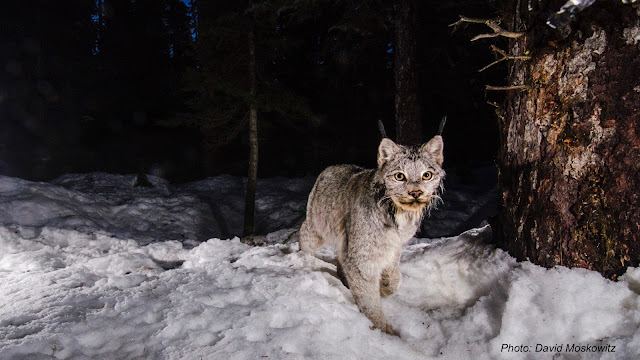Paul G. Allen Family Foundation support for the Lynx and Wildfire project
Since the inception of Home Range a little over a year ago, we have been working towards a large-scope, interdisciplinary project aimed at providing important information for the conservation of Canada lynx. Now, we are thrilled to announce that with funding support from the Paul G. Allen Family Foundation, our research on lynx and wildfire in the North Cascades begins this winter.
These maps paint a clear picture as to why this research is urgently needed. The dark green areas show Washington’s lynx habitat, with the orange areas showing where fires burned between 1970 and 1999 (left map) and 2000 and 2021 (right map). In the past 20 years, North Cascades lynx habitat has flip-flopped from being mostly unburned to mostly burned. Climate change, in conjunction with a legacy of fire suppression, has created a tinder box on our landscape. Anyone that lives or spends time in the Methow Valley knows that wildfires have increased to the point that we regularly experience megafires (fires over 100,000 acres). We’ve all felt the effects of wildfires, and for our wildlife community, these maps convey with no uncertainty that for a forest dwelling species such as Canada lynx, wildfires have caused dramatic change. Accordingly, lynx were up-listed in Washington from threatened to endangered in 2016 because as wildfires increase under climate change, there will be less and less forest for lynx to live in, meaning this iconic species, found in only six places in the lower 48, is in danger of local extinction. The problem is this: we know very little about how megafires affect lynx other than that very recent, severe, large fires generally don’t support lynx. Without more scientific information, we can’t know how to help lynx.
Not only are answers regarding the effects of megafires on lynx needed as soon as possible, our landscape currently offers a tremendous opportunity to learn this information. Last winter we were able to conduct pilot work surveying for lynx tracks in the 2006 Tripod Burn. This is an area that even just 6 years ago track surveys indicated that it hadn’t regrown enough to provide habitat for lynx. But this past winter over just five days of field surveys, we marked 57 sets of tracks, suggesting a significantly higher level of lynx activity. This pilot data validates our notion that we have a valuable opportunity to learn how fire can not only take away lynx habitat, but about the conditions under which it can regrow into lynx habitat. This knowledge is important because if we can tease apart what burned habitats lynx do and do not use, we can help craft forest treatment plans that enhance burned lynx habitat and reduce fuels to dampen the effects of future fires. The ability to meet both of these objectives would not only be a win for lynx since it would slow the loss of lynx habitat to recent, severe fires, but it would also be a win for our community who would experience less wildfire.
Learning how lynx respond to megafires, however, is no small undertaking. It will require years of live-trapping and GPS collaring lynx, backtracking lynx in the snow to record the details of the habitat they use, and setting large trail camera arrays, all of which takes crews of skilled biologists and wildlife trackers to accomplish. At Home Range we are eager to undertake this challenge, but we could not do it without our community, our team of collaborators made up of lynx experts, foresters, and wildfire ecologists, our agency partners at the U.S. Forest Service and the Washington Department of Fish and Wildlife, and our academic partner, the University of British Columbia. We are so grateful for all of your support!
Our 2023 launch of the lynx and wildfire project would not have been possible without the generous support of the Paul G. Allen Family Foundation, whose dedication to conservation makes important research possible. We are deeply thankful for their recognition of the urgent situation that climate-driven megafires present to western lynx populations and for the financial support the Paul G. Allen Family Foundation has awarded us for the first three years of our research.


